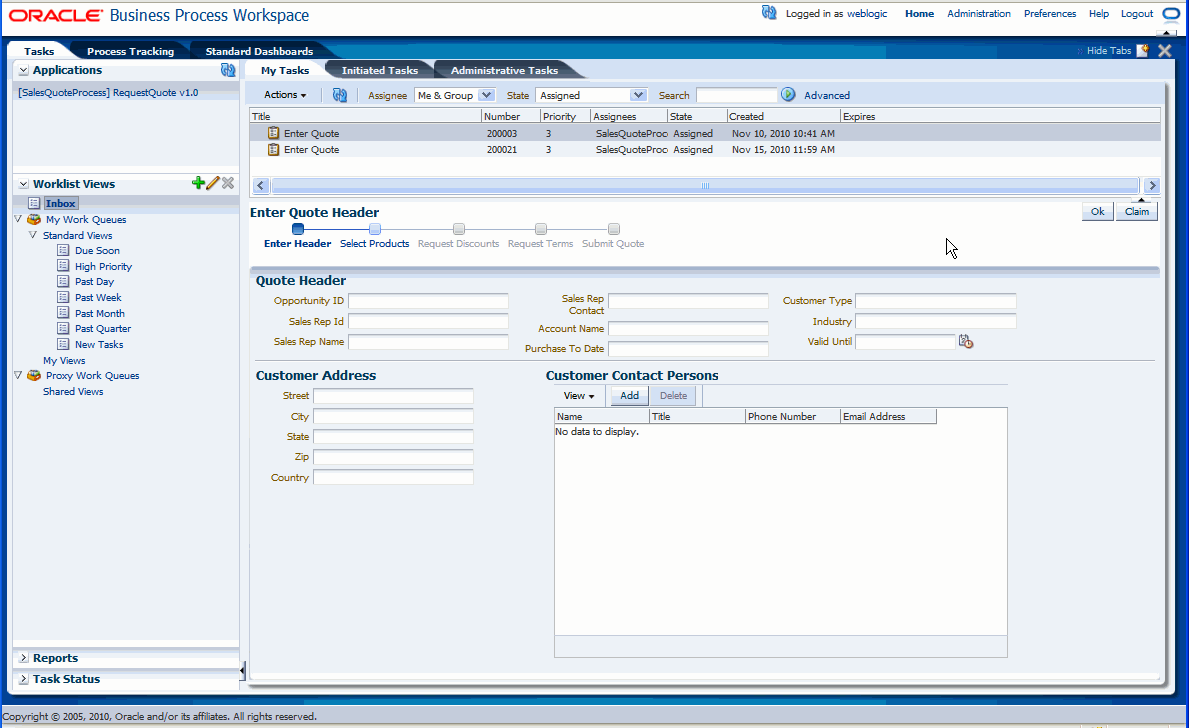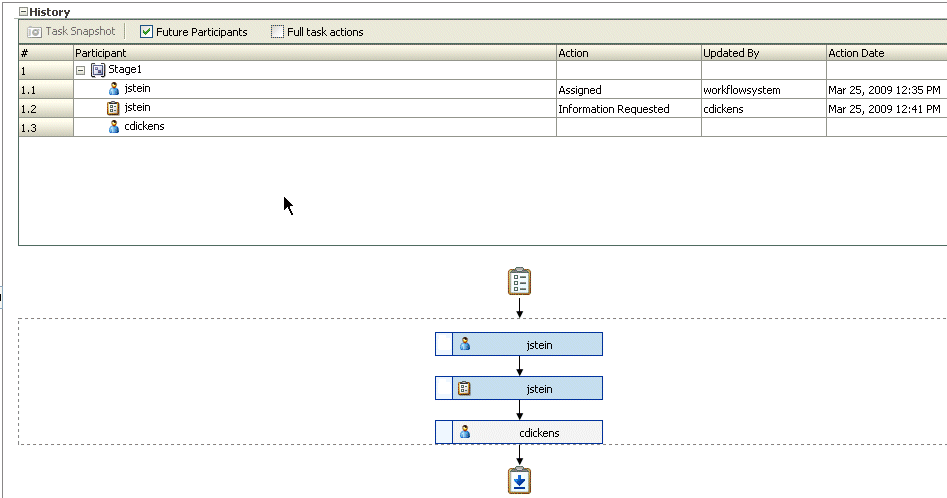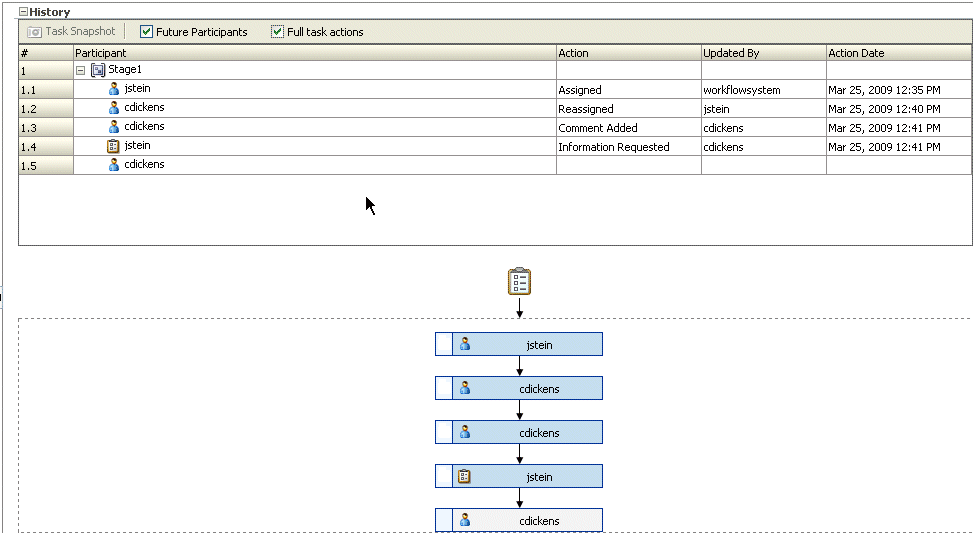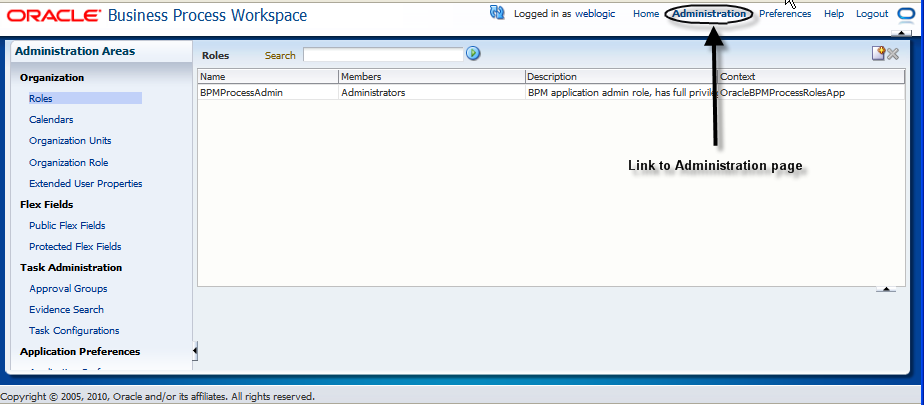2 Getting Started with Process Workspace
Process Workspace is a customizable web-based interface enabling users to access and manage tasks and process instances according to their roles and responsibilities. This chapter tells you how to start and log in to Process Workspace, navigate its interface, and configure your preferences.
To help you get started with Process Workspace, this chapter contains these topics:
2.1 Understanding Process Workspace
Table 2-1 lists and describes the users for whom Process Workspace is designed.
Table 2-1 Users of Oracle Business Process Management Workspace
| User Profile | Description |
|---|---|
|
Process Participants |
This is the most basic profile, common to all users. It enables you to:
These users may be spread throughout the organization or work outside the company. A process participant may be one who not only initiates the process, but can also track its progress and, if appropriate, withdraw it. |
|
Process Owners |
Users who manage one or more business process. They want to know how process instances are moving in those processes. To get this perspective, they typically use dashboards. These users usually reside on the business side of the house as part of the operations organization. They may also be supervisors. |
|
Administrators |
Includes two types of administrative users:
|
|
Supervisors |
Users with other process participants reporting to them. To ensure that process instances execute as expected, supervisors can:
|
For personas related to accessing task information, see Oracle Fusion Middleware Developer's Guide for Oracle SOA Suite.
Process analysts typically use the Oracle Business Process Analysis Suite or Business Process Composer to create process models. They can also use process analyst role within Oracle BPM Studio.
Process developers typically use Oracle BPM Studio to model and implement the components of a business application. They may occasionally use Oracle Business Process Composer (Business Process Composer) for modeling basic processes.
2.2 Starting and Logging In to Process Workspace
To start Process Workspace, you must have installed Oracle SOA Suite, and the SOA server must be running. See your installation documentation for more information.
To start and log into Process Workspace:
-
Go to
http://host_name:port_number/bpm/workspace/The
host_nameis the name of the host computer on which Oracle SOA Suite is installed.The
port_numberis the one used at installation. -
Enter the user name and password.
You can use the preseeded user name to log in as an administrator. If you have loaded the demo user community in the identity store, then you can use other users such as jstein or jcooper.
The user name and password must exist in the user community provided to JAZN.
-
Click Login.
Notes:
-
If you expect to have a large number of users using Process Workspace simultaneously, then set the session time-out value to no more than 5 minutes. To do this, expand the Process Workspace
.earfile, open theweb.xmlfile, and update the time-out parameter. -
If user identities are stored in Microsoft Active Directory, then at times authentication can fail due to the inability of Oracle WebLogic Server, where Process Workspace is running, to communicate with the Active Directory installation. This can occur when Oracle WebLogic Server and Active Directory are in separate domains.
To resolve this issue, add the entry for the Active Directory host's address to the
/etc/hostsfile on machine where Process Workspace is running.
2.3 Navigating Process Workspace
At the highest level, Process Workspace provides three default tabs as shown in Figure 2-1:
-
Tasks
-
Process Tracking
-
Standard Dashboards
It also provides a link in the top right toolbar for performing administration.
Figure 2-1 shows the Process Workspace user interface as it first opens after you log in. At the highest level, the tabs are Tasks, Process Tracking, and Standard Dashboards. The Administration link is in the upper right toolbar.
In addition to the default tabs, you can create your own custom tabs, with each one appearing as a separate page in Process Workspace. For more information about creating custom tabs, see Chapter 5, "Creating and Editing Custom Pages in Process Workspace".
This section contains these topics:
-
Section 2.3.2, "About the Process Workspace Process Tracking Page"
-
Section 2.3.3, "About the Process Workspace Standard Dashboards Page"
2.3.1 About the Process Workspace Tasks Page
After a user logs in, the Home page, as shown in Figure 2-1, displays the Tasks page by default. The Tasks page displays tasks for the user based on the user's permissions and assigned groups and roles.
Within the Tasks page, the My Tasks page and the Inbox are displayed by default. The actions allowed from the Actions list depend on the logged-in user's privileges.
The Tasks page enables you to do the following:
-
Perform authorized actions on tasks in the worklist, acquire and check out shared tasks, define personal to-do tasks, and define subtasks.
-
Filter tasks in a worklist view based on various criteria.
-
Work with standard work queues, such as high priority tasks, tasks that are due soon, and so on. Work queues enable users to create a custom view to group a subset of tasks in the worklist—for example, high priority tasks, tasks due in 24 hours, expense approval tasks, and more.
-
Define custom work queues.
-
Gain proxy access to part of another user's worklist.
-
Define custom vacation rules and delegation rules.
-
Enable group owners to define task dispatching rules for shared tasks.
-
Collect a complete workflow history and audit trail.
-
Use digital signatures for tasks.
Note:
If you change a user's privileges in Oracle Enterprise Manager Fusion Middleware Control Console while the user is logged in to Process Workspace, the changes take effect only after a subsequent login by the user. This is true for situations in which there are two active worklist sessions: one in which the user is logged in before the privileges are changed, and one in which the same user logs in after the privileges are changed. In the first case, the changes to the user's privileges do not take effect while the user is logged in. In the second case, when the user logs in to the second instance of Process Workspace, the changes to the user's privileges do take effect.2.3.1.1 Navigating the Process Workspace Tasks Page
This page lists all the tasks and work items assigned to you, depending on your role. For example, all users will see the My Tasks and Initiated Tasks pages. Only supervisors will see the My Staff page, and only administrators will see the Administration Tasks page. The Tasks page has these sections, as shown in Figure 2-2:
-
Task navigator on the left
-
Task list on the upper half of the right side
-
Task details on the lower half of the right side
Table 2-2 Components of the Tasks Page
| Component | Description |
|---|---|
|
Tabs |
The tabs displayed depend on the role granted to the logged-in user.
|
|
Applications |
The processes the user is authorized to initiate. |
|
Worklist Views |
|
|
Task Status |
A bar chart shows the status of tasks in the current view. |
|
Display Filters |
Specify search criteria from the Assignee, Status, or Search fields. The category filters that are available depend on which tab is selected.
Use Search to enter a keyword or use Advanced Search. |
|
Actions List |
Select a group action (Claim) or a custom action (for example, Approve or Reject) that was defined for the human task. Claim appears for tasks assigned to a group or multiple users; one user must claim the task before it can be worked. Other possible actions for a task, such as system actions, are displayed on the Task Details page for a specific task. You can also create ToDo tasks and subtasks here. |
|
Default Columns |
Title—The title specified when the human task was created. Tasks associated with a purged or archived process instance do not appear. Number—The task number generated when the BPEL process was created. Priority—The priority specified when the human task was created. The highest priority is 1; the lowest is 5. Assignees—The user or group or application roles. State—Select from Assigned, Completed, Errored, Expired, Information Requested, Stale, Suspended, or Withdrawn. Created—Date and time the human task was created. Expires—Date and time the tasks expires, specified when the human task was created. |
|
Task Details |
The lower section of the worklist displays the inline view of the Task Details page. Buttons indicate available actions. |
2.3.1.2 The Process Workspace Task Details Page
Figure 2-3 shows an example of a Task Details page. This page is invoked by selecting a task from the inbox on the Process Workspace Tasks page.
Figure 2-3 Example of a Task Details Page
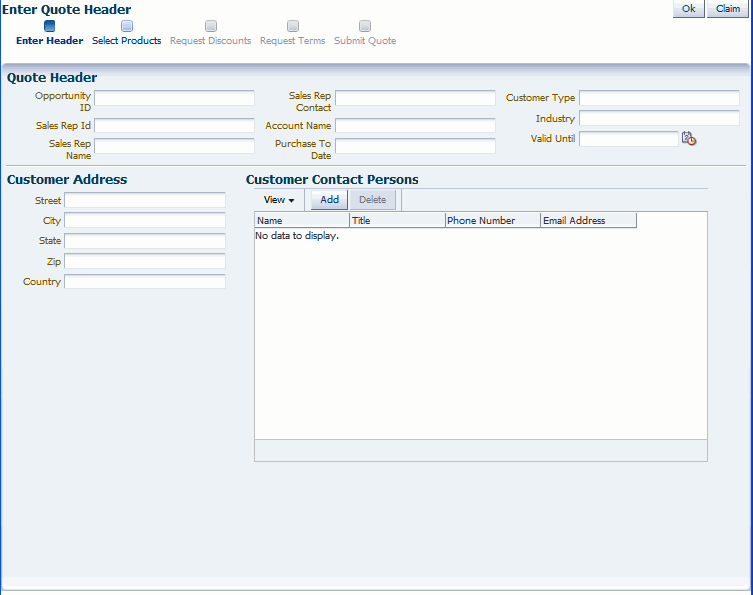
Description of "Figure 2-3 Example of a Task Details Page"
The task details page has the following components:
-
Basic information including the title of the task—for example, Help Desk Request for wfaulk—task number, creator, assignees, state, created date, the person who acquired the task, priority, expiration date, and other flex fields.
-
Action buttons—For custom actions defined in the human task—for example, Resolved and Unresolved for a help desk request or Approve and Reject for a loan request. For the administrator, task initiator, or manager, Withdraw may also appear.
-
Other Actions—System task actions, beyond the custom actions defined for the task—as described in Table 2-2.
Action Description Claim
If a task is assigned to a group or multiple users, then the task must be claimed first. Claim is the only action available in the Action list for group or multiuser assignments. After a task is claimed, all applicable actions are listed.
Escalate
If you are not able to complete a task, you can escalate it and add an optional comment in the Comments area. The task is reassigned to your manager (up one level in a hierarchy).
Pushback
Use this action to send a task down one level in the workflow to the previous assignee.
Reassign
If you are a manager, you can delegate a task to reportees. A user with BPMWorkflowReassign privileges can delegate a task to anyone.
Release
If a task is assigned to a group or multiple users, it can be released if the user who claimed the task cannot complete the task. Any of the other assignees can claim and complete the task.
Renew
If a task is about to expire, you can renew it and add an optional comment in the Comments area. The task expiration date is extended one week. A renewal appears in the task history. The renewal duration for a task can be controlled by an optional parameter. The default value is
P7D(7 days).Submit Information and Request Information
Use these actions if another user requests that you supply more information or to request more information from the task creator or any of the previous assignees. If reapproval is not required, then the task is assigned to the next approver or the next step in the business process.
Suspend and Resume
If a task is not relevant, you can suspend it. These options are available only to users who have been granted the BPMWorkflowSuspend role. Other users can access the task by selecting Previous in the task filter or by looking up tasks in the Suspended status. A suspension is indefinite. It does not expire until Resume is used to resume working on the task.
Withdraw
If you are the creator of a task and do not want to continue with it, for example, you want to cancel a vacation request, you can withdraw it and add an optional comment in the Comments area. The business process determines what happens next. You can use the Withdraw action on the home page by using the Creator task filter.
-
Content—The payload. The fields displayed are specific to how the human task was created.
-
Short History—Provides a graphical view of a task flow and lists all versions created by the following tasks:
-
Initiate task
-
Reinitiate task
-
Update outcome of task
-
Completion of task
-
Erroring of task
-
Expiration of task
-
Withdrawal of task
-
Alerting of task to the error assignee
You can include the following actions in the short history list by modifying the
shortHistoryActionselement.-
Acquire
-
Ad hoc route
-
Auto release of task
-
Delegate
-
Escalate
-
Information request on task
-
Information submit for task
-
Override routing slip
-
Update outcome and route
-
Push back
-
Reassign
-
Release
-
Renew
-
Resume
-
Skip current assignment
-
Suspend
-
Update
-
-
History Details—The approval sequence and the update history for the task.
To see all actions performed, including those that do not change the task, such as adding comments, check Full History.
-
Comments and Attachments:
-
Comments entered by various users who have participated in the workflow. A newly added comment and the commenter's user name are appended to the existing comments. A trail of comments is maintained throughout the life cycle of the task. To add or delete a comment, you must have permission to update the task.
For information about how to add a comment, see Section 3.7, "Associating Comments and Attachments with Tasks in Process Workspace"
-
Attachments are documents or reference URLs associated with a task. These are typically associated with the workflow as defined in the human task or attached and modified by any of the participants using the task list. To add or delete an attachment, you must have permission to update the task. When adding file attachments, you can use an absolute path name or browse for a file.
-
2.3.1.2.1 Task History
The task history maintains an audit trail of the actions performed by the participants in the workflow and a snapshot of the task payload and attachments at various points in the workflow. The short history for a task lists all versions created by the following tasks:
-
Initiate task
-
Reinitiate task
-
Update outcome of task
-
Completion of task
-
Erroring of task
-
Expiration of task
-
Withdrawal of task
-
Alerting of task to the error assignee
You can include the following actions in the short history list by modifying the shortHistoryActions element.
-
Acquire
-
Ad hoc route
-
Auto release of task
-
Delegate
-
Escalate
-
Information request on task
-
Information submit for task
-
Override routing slip
-
Update outcome and route
-
Push back
-
Reassign
-
Release
-
Renew
-
Resume
-
Skip current assignment
-
Suspend
-
Update
The history provides a graphical view of a task flow, as shown in Figure 2-4.
Table 2-4 describes the icons used in the Task History section.
Table 2-4 Icons for Task History
| Icon | Description |
|---|---|
|
Indicates an approver in an ad hoc routing scenario. |
|
|
Indicates that the task has been approved |
|
|
Indicates that the participant just receives a notification task and the business process does not wait for the participant's response. Participant cannot directly impact the outcome of a task, but in some cases can provide comments or add attachments. |
|
|
Indicates that a set of people must work in parallel. This pattern is commonly used for voting. |
|
|
Indicates that the participant belongs to a management chain. |
|
|
Indicates the simple case in which a participant maps to a user, group, or role. |
|
|
Indicates that the task is untouched |
Select Full task actions to see all actions performed, including those that do not make changes to the task, such as adding comments, as shown in Figure 2-5.
Available ways to view the task history include:
-
Take a task snapshot
-
See future approvers
-
See complete task actions
2.3.2 About the Process Workspace Process Tracking Page
Use the Process Tracking page to interact with business processes based on the roles assigned to you.
Using the Process Tracking tab, you can do the following:
-
View the list of process instances pending in your inbox.
-
Execute tasks. That is, carry out a human task on a particular instance.
-
Search for instances by different criteria.
-
Save the searches as a view.
-
View the details of an instance, including the audit trail.
-
Create a new instance, if you have permission to do so.
-
Attach a file to an instance.
-
Add notes to an instance.
2.3.2.1 Navigating the Process Workspace Process Tracking Page
Figure 2-6 Process Workspace Process Tracking Page
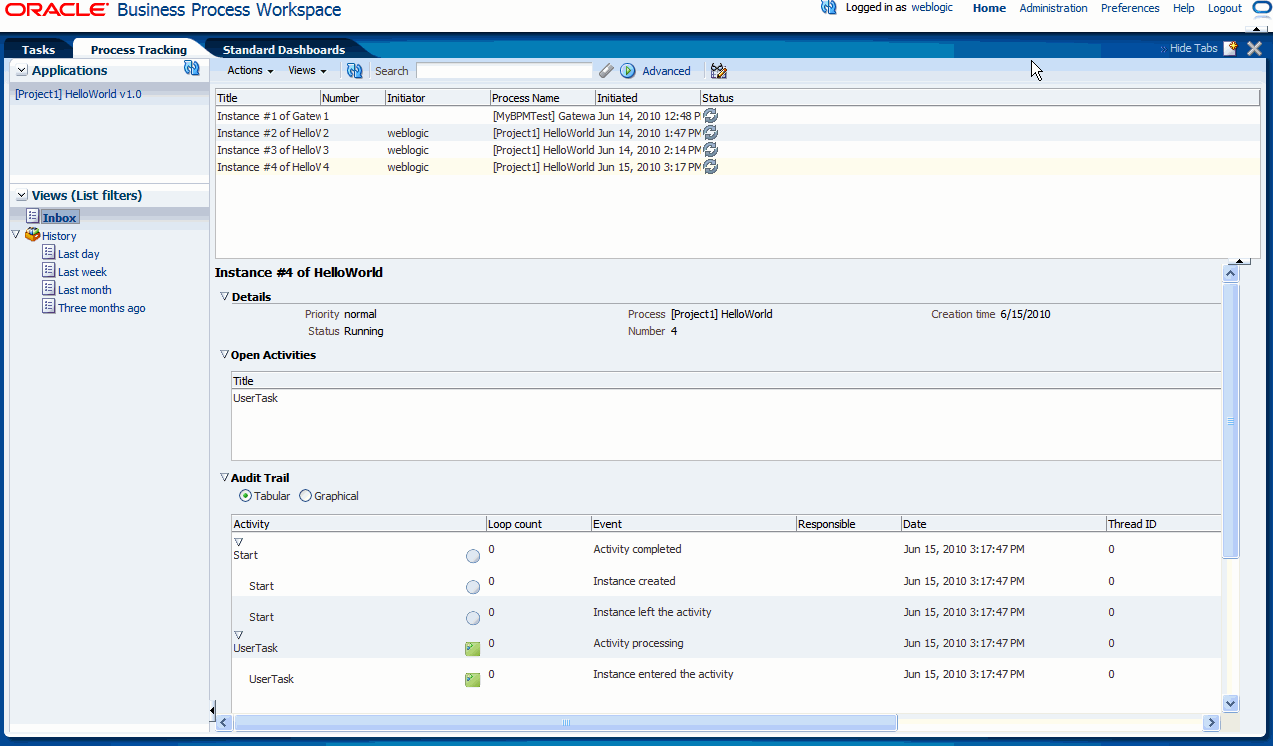
Description of "Figure 2-6 Process Workspace Process Tracking Page"
The Process Tracking page has these sections:
-
The Applications panel, which shows the list of applications available to you. Here you can perform basic Process Workspace actions, such as creating a new instance or performing a given activity.
The applications available in Process Workspace depend on the process design and the roles assigned to the user currently logged in. The list of applications available also depends on the BPM processes that are deployed and running. The applications panel will be empty if no processes are running or if you are not a participant able to execute an application in any of the processes currently running.
-
The Views panel, on the lower left half, displays the views available to you in an expandable tree
-
The Work Items panel, on the upper right half, shows the task items corresponding to the view you have selected in the Views panel.
-
The Work Item Detail panel, on the lower right half, shows detailed information about a work item that you have selected in the Work Items panel.
In the Work Items panel, you can choose the columns that are presented in a given view. A particular column arrangement is known as presentation. Clicking Add/Remove columns displays the Presentation dialog box in which you can define columns.
The following columns are available:
-
Actions
-
Activity
-
Activity Due Date
-
Copy
-
Creation Time
-
Deadline
-
Description
-
Has Attachments
-
Has Notes
-
Initiated
-
Initiator
-
Initiator Name
-
Instance #
-
Parent Copy
-
Participant
-
poID
-
Priority
-
Process Name
-
Process Due Date
-
Received
-
Status
-
Task Participant
-
Title
2.3.2.2 The Process Workspace Process Audit Details Panel
The Process Audit Details panel is shown in the lower right half of Figure 2-7. It appears when you select a process instance in the Work Items panel just above it.
The Process Audit Details panel displays the priority, process name, when the instance is due to complete, status, creation time, and the assignee if any.
If the selected process instance has any gateways with threads that are still running, the Open Activities section displays their status.
The Audit Trail section displays audit information in either tabular form or graphically depending on your selection.
2.3.3 About the Process Workspace Standard Dashboards Page
Dashboards provide analytical information to monitor process execution as well as user workloads. They provide summary information and enable you to drill down to instance-specific information.
Figure 2-8 shows the Standard Dashboards page.
Figure 2-8 Process Workspace Standard Dashboards Page
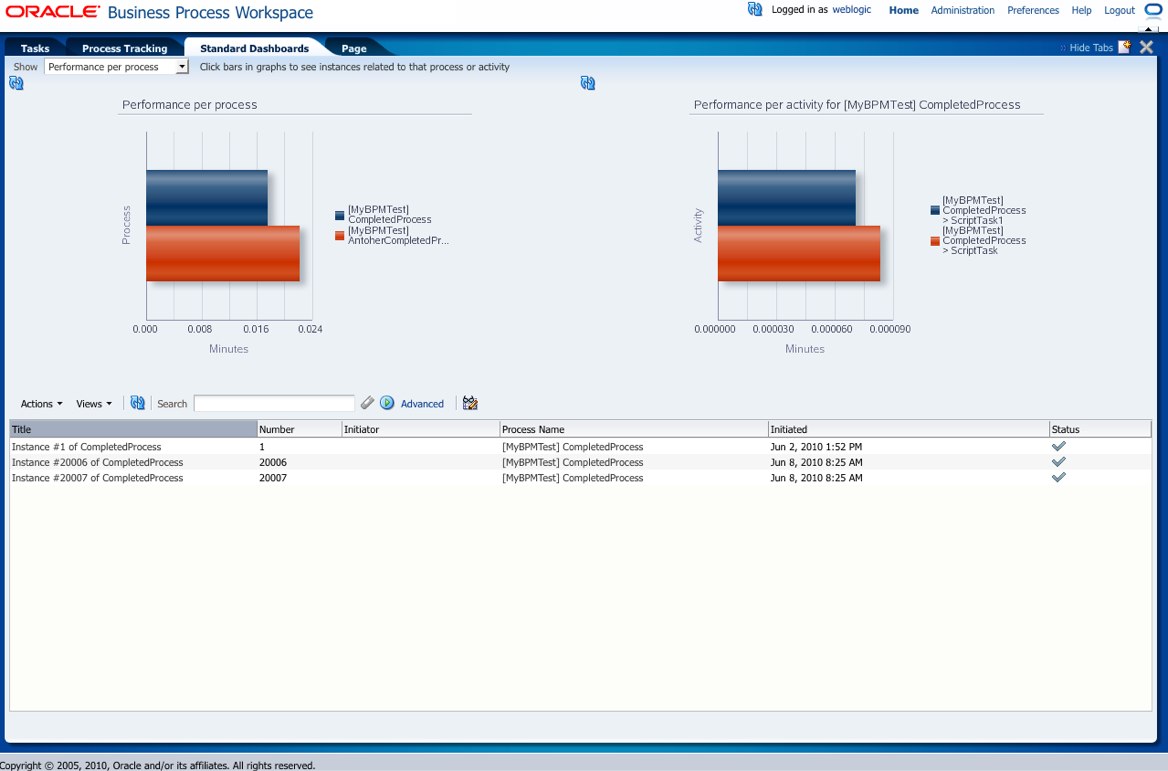
Description of "Figure 2-8 Process Workspace Standard Dashboards Page"
For additional information about dashboards, see Chapter 6, "Using Dashboards in Process Workspace".
2.4 Accessing Administration Capabilities
The upper right toolbar contains an Administration link as shown in Figure 2-9.
Table 2-5 lists and describes the categories in the Administration Areas and tells where to find more information about each one.
Table 2-5 Categories in the Administration Areas
| Category | Description | Information |
|---|---|---|
|
Organization |
Model an organization by defining organizational units, business calendars, business holidays, roles, and other user properties. Note: If you are logged into Process Workspace, and changes are made to your organizational membership, you will not see these changes reflected in the interface until you log out and log back in again. This is because, for better performance, the organizational unit information is cached when you log into Process Workspace. |
Section 8.3, "Managing Your Organization in Process Workspace" |
|
Flex Fields (Mapped Attributes) |
Create mappings needed for populating mapped attributes. |
Section 8.4.1, "Managing Mapped Attributes (Flex Fields) in Process Workspace" |
|
Task Administration |
Administer approval groups, task configuration, evidence search, and exceptions |
Section 8.4, "Administering and Configuring Task-Related Information in Process Workspace" |
|
Application Preferences |
Customize the appearance of the worklist. |
Section 8.1, "Setting the Display of the Work Items Panel in Process Workspace" |
2.5 Setting Your Preferences in Process Workspace
Table 2-6 lists and describes the preferences you can set and tells you where to find information for setting each preference.
| Preference | Description | Information |
|---|---|---|
|
Specify your preferred language and time zone. |
Oracle Fusion Middleware Developer's Guide for Oracle SOA Suite |
|
|
Provide a digital certificate from a certification authority to verify your credentials. |
Section 3.5, "Providing a Digital Certificate in Process Workspace". |
|
|
Set rules for tasks assigned to a user or group. |
Section 3.9.1, "How to Create User Rules in Process Workspace" Section 3.9.2, "How to Create Group Rules in Process Workspace" |
|
|
Setting notification preferences |
Configure the notification settings to control how, when, and where you receive messages in cases when you have access to multiple communication channels (delivery types). |
Section 3.9.4, "How to Set Notification Preferences in Process Workspace". |
|
Setting accessibility preferences |
Select accessibility preferences such as using a screen reader, using high contrast colors, and large fonts. |
Section 3.4, "Setting Accessibility Preferences in Process Workspace" |
